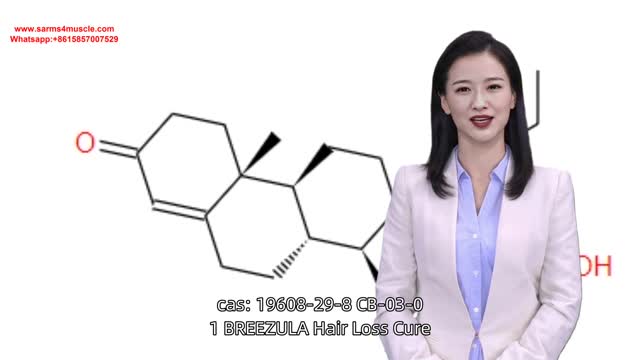Premium Only Content

cas: 19608-29-8 CB-03-01 BREEZULA Hair Loss Cure
cas: 19608-29-8 CB-03-01 BREEZULA Hair Loss Cure
What is CB-03-01?
CB-03-01 (cortexolone 17α-propionate, CB0301) 1% cream is a topical androgen receptor inhibitor which has mainly been developed for the treatment of acne vulgaris (1). It is also presently being investigated in a large phase II clinical trial for the topical treatment of male-pattern baldness. CB-03-01 has been found to inhibit the androgen receptor regulated pathway (1). Also known as clascoterone, CB-03-01 is being developed by Cassiopea (a spin-off company from Cosmo Pharmaceuticals) and was initially commercialised as Breezula. Data from 2020 reveal that clascoterone is also being marketed as Winlevi for the management of acne vulgaris. CB-03-01 is thought to compete with DHT for its binding to androgen receptors in both the sebaceous gland and dermal papilla cells within hair follicles. The difference between Winlevi and Breezula is that Breezula is a solution that contains a higher concentration of the drug for the treatment of male-pattern baldness(2). In 2019, Cassiopea announced positive phase II 12-month results for their flagship product Breezula in the management of androgenetic alopecia. The phase II clinical trial recruited in excess of 400 participants in Germany and sought to evaluate the efficacy and safety of 4 different dosing regimens of CB-03-01 compared to vehicle agents in male subjects between the ages of 18 and 55 with mild to moderate male-pattern baldness. All participants were randomised to either apply CB-03-01 or a vehicle agent to balding areas of the scalp daily for 12 months. 5 treatment groups were analysed – 2.5% solution twice-daily, 5.0% solution twice-daily, 7.5% solution twice-daily, 7.5% solution once-daily, and vehicle solution twice-daily.
Researchers used target area hair count (TAHC) and hair growth assessment (HGA) score as the primary end-points of interest. For TAHC, statistically significant changes versus the vehicle agent were observed in all of the active treatment groups, with the most significant improvements observed in the 7.5% twice-daily
-
 LIVE
LIVE
In The Litter Box w/ Jewels & Catturd
22 hours ago1 TRILLION! | In the Litter Box w/ Jewels & Catturd – Ep. 733 – 2/3/2025
5,565 watching -
 1:38:44
1:38:44
The Quartering
2 hours agoTrump's Tariffs Already Work, Blackhawk Pilot Coverup, DNC Makes Insane David Hogg Appointment
20.6K12 -
 LIVE
LIVE
Dr Disrespect
4 hours ago🔴LIVE - DR DISRESPECT - TARKOV - ZERO TO HERO RAIDS ONLY
4,394 watching -
 1:13:51
1:13:51
Candace Show Podcast
2 hours agoEXCLUSIVE! Did Ryan Reynolds Extort Hollywood Execs? | Candace Ep 143
11.5K28 -
 LIVE
LIVE
Darkhorse Podcast
2 hours agoThe 263rd Evolutionary Lens with Bret Weinstein and Heather Heying
809 watching -
 9:37
9:37
Silver Dragons
1 hour agoGoodbye Cheap Silver - How the Tariffs Will Change Stacking Forever
61 -
 37:33
37:33
CryptoWendyO
1 hour agoWORST DAY IN CRYPTO HISTORY $10 Billion in Liquidations!
284 -
 57:01
57:01
PMG
2 hours agoHannah Faulkner and Dr. Bryan Ardis | Don't Fall For the Bird Flu!!!
112 -
 1:18:00
1:18:00
Russell Brand
1 day agoUFOs, Whistleblowers, and Government Lies – The Truth with Jeremy Corbell – SF530
147K55 -
 1:57:47
1:57:47
The Charlie Kirk Show
3 hours agoThe Most Beautiful Word in English + Confirm Tulsi! | Navarro, McCain, Posobiec | 2.3.2025
146K36